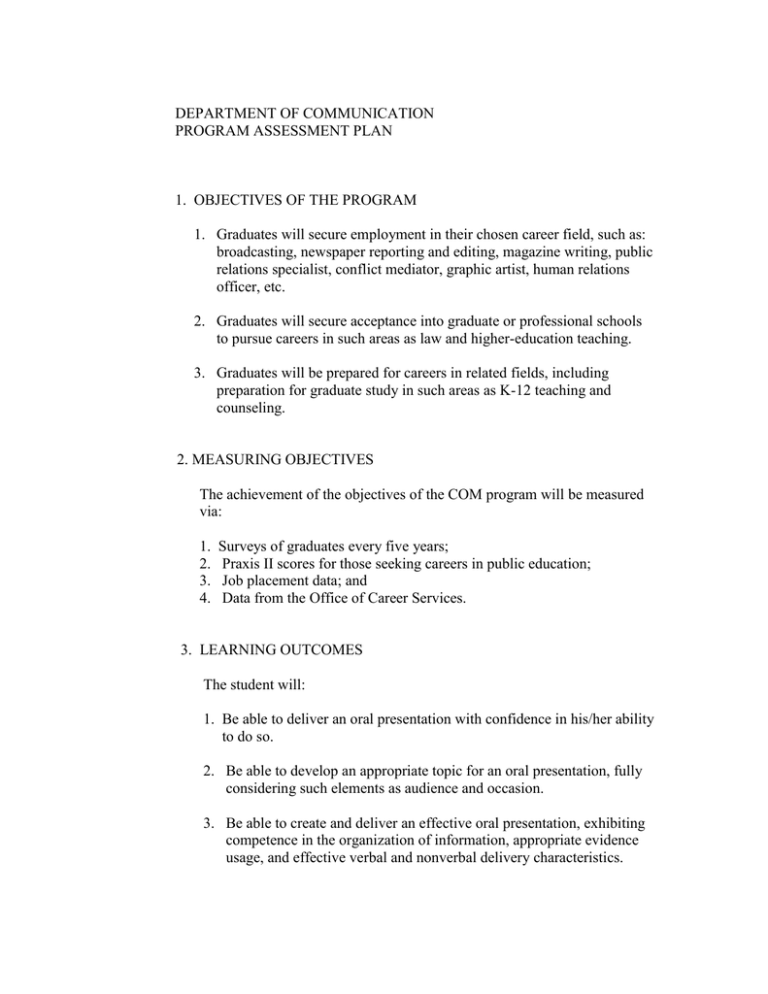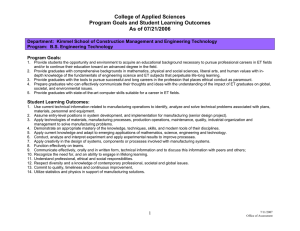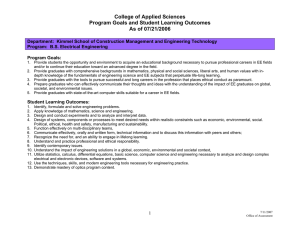DEPARTMENT OF COMMUNICATION PROGRAM ASSESSMENT PLAN 1. OBJECTIVES OF THE PROGRAM
advertisement

DEPARTMENT OF COMMUNICATION PROGRAM ASSESSMENT PLAN 1. OBJECTIVES OF THE PROGRAM 1. Graduates will secure employment in their chosen career field, such as: broadcasting, newspaper reporting and editing, magazine writing, public relations specialist, conflict mediator, graphic artist, human relations officer, etc. 2. Graduates will secure acceptance into graduate or professional schools to pursue careers in such areas as law and higher-education teaching. 3. Graduates will be prepared for careers in related fields, including preparation for graduate study in such areas as K-12 teaching and counseling. 2. MEASURING OBJECTIVES The achievement of the objectives of the COM program will be measured via: 1. 2. 3. 4. Surveys of graduates every five years; Praxis II scores for those seeking careers in public education; Job placement data; and Data from the Office of Career Services. 3. LEARNING OUTCOMES The student will: 1. Be able to deliver an oral presentation with confidence in his/her ability to do so. 2. Be able to develop an appropriate topic for an oral presentation, fully considering such elements as audience and occasion. 3. Be able to create and deliver an effective oral presentation, exhibiting competence in the organization of information, appropriate evidence usage, and effective verbal and nonverbal delivery characteristics. 4. Be able to develop written messages for varying audiences, including both media and media organizations. 5. Be able to exhibit competence in basic writing skills, including spelling, grammar, and syntax. 4/5. MEASURING LEARNING OUTCOMES Both oral and written skills will be measured throughout the student’s undergraduate studies in his/her Communication courses, all culminating COM 400, “Senior Seminar in Communication,” wherein each student must present an effective persuasive presentation and turn-in a portfolio of written work. The same assessment instrument, modified from an instrument developed by the National Communication Association, is used in all oral communication courses, from COM 101, the introductory public speaking course, through COM 400, the senior seminar. The factors assessed via this instrument require that a student receive a 75% rating to successfully complete the oral communication component. Specifically, the attainment and assessment of the program’s learning outcomes will be measured via oral presentations, a final portfolio, and an exit survey in COM 400. 6. DERIVING FINDINGS Every year the Department of Communication Assessment Committee collects data from our major oral and written communication courses (COM 101; COM 200; COM 399; COM 400) to assess the performance of COM majors in the areas of speaking and writing. Additionally, the results from the exit surveys completed by students in COM 400 are analyzed by this committee. These data and analyses are supplemented every five years by a survey of recent program graduates. The results from this assessment are then communicated to the department faculty and, more specifically, to the department’s curriculum committee for study and action. This reporting function is undertaken by the department’s Assessment Committee at the start of each winter term. 7. IMPLEMENTING IMPROVEMENTS This assessment is used to (a) make modifications in the content of courses throughout the COM curriculum and/or to (b) make modifications in the layout of COM major programs. It was this sort of study that led the department to add a fourth specialization area to the Mass Communication Major (“Visual Communication”) four years ago, based upon the feedback received from the exit survey in COM 400, the senior seminar. Thus, the process is as follows: information collection; analysis by the Assessment Committee; analysis and recommendations by the Curriculum Committee; final action by the full departmental faculty. 8. TIMETABLE Our assessment process proceeds along annually, quarter by quarter, with recommendations coming forth from both the Assessment Committee and the Curriculum Committee each winter term. The survey of program graduates occurs every five years, with the next survey scheduled for spring term 2005. 9. NOT APPLICABLE 10. COMMUNICATION Program objectives, learning outcomes, and changes to programs are communicated to students through the University catalog, the Department of Communication website, and through the advising process.


